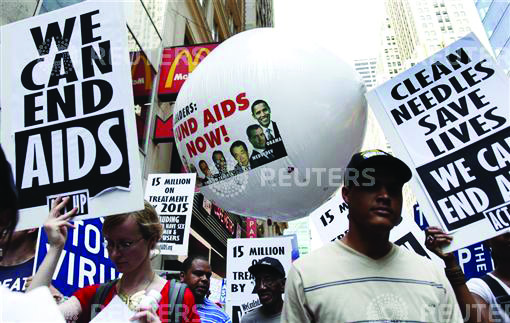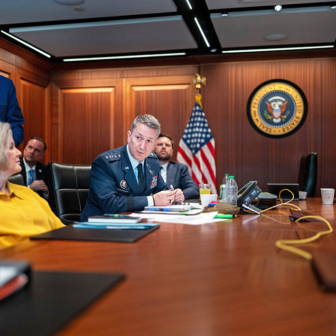THIRTY years ago, in June 1981, the Morbidity and Mortality Weekly Report – a government publication read mainly by public health officials – published the first mention of the disease we now call AIDS. Five previously healthy young gay men in Los Angeles had been diagnosed with Pneumocystis carinii pneumonia, an infectious disease usually seen only in people with profoundly impaired immune systems.
A month later, the same publication reported that about twenty-six previously healthy gay men from Los Angeles, San Francisco and New York with severely compromised immune systems had developed both Pneumocystis pneumonia and an unusual form of cancer called Kaposi’s sarcoma. Soon more and more people were presenting with these symptoms and very quickly dying painful deaths. Doctors felt helpless, health officials were apprehensive, and the public was panicking. Scientists began to consider that we might be dealing with a new infectious microbe. Others saw something more sinister – a “gay plague” sent to punish those whose lifestyles they didn’t agree with.
In 1981 I was a postdoctoral researcher working in infectious diseases at the US Department of Defense Medical School in Bethesda, Maryland. I remember going to scientific meetings, standing in packed rooms, to hear about the early research on this new disease. Many people wanted to believe that this was a lifestyle disease, but as cases emerged in intravenous drug users, in people who had received blood transfusions and finally in women and newborns, it became clear that this was a sexually transmitted infectious disease. “Acquired Immune Deficiency Syndrome” was defined by the Centers for Disease Control and Prevention just two months before the first case was diagnosed in Australia.
By 1984 I was working as a health policy adviser in the US Congress. We held hearing after hearing on a range of issues relating to HIV/AIDS. There was much to understand: the science of a new viral infection, how to protect the blood supply and prevent transmission, the costs of new drug therapies, patent rights for diagnostic tests, and how to tackle discrimination and help patients get access to treatment and care. The scientists, policy-makers, gay activists and concerned community groups constantly ran up against ignorance and bias.
We couldn’t use federal funds to promote condom use or for clean needle programs, for example, and persuading members of Congress to vote for action in the face of opposition from conservative fundamentalists was hard work. It was not until 1990 that the Ryan White Comprehensive AIDS Resources Emergency Act was enacted, named in honour of an Indiana teenager, a haemophiliac, who contracted AIDS in 1984 and was expelled from school. It wasn’t until twenty years later that the Obama administration finally lifted the ban on the use of federal funds for syringe-exchange programs and produced the first National HIV/AIDS Strategy.
Although Australia was not without its own hysteria, rationality won out. Beginning in 1985, the federal government mounted an effective policy response, culminating in the world’s first national HIV/AIDS strategy – frequently held up as a model of global best practice – in 1989.
The discovery of antiretroviral therapy and advances in treatment have had a major impact, helping to shift the course of the disease and dramatically reducing the number of AIDS-related deaths. These advances have brought complacency, and yet the epidemic persists; we have simply stopped paying attention, both at home and internationally. In Australia, more than 20,000 people live with HIV/AIDS, and over 1000 new infections occur each year, mostly as a result of men having sex with men. The situation is much worse in the United States, where someone is infected every nine minutes. More than a million Americans are living with HIV/AIDS; many people don’t know they are infected, and of those who do, more than 60 per cent are not in the care of a specialist medical provider.
The epidemic continues to primarily affect socially stigmatised groups – people of colour (especially African-Americans) and low-income and homeless individuals – and this has had a significant negative impact on prevention and treatment efforts in the hardest-hit communities. It’s interesting to speculate on the strength of the community response in America if HIV/AIDS had not been first diagnosed as a disease of white, middle-class men – a group that could mobilise to tackle stigma.
To get some sense of it, we need look no further than here in the nation’s capital, where infection rates rival those of East Africa. More than 3 per cent of Washington residents aged over twelve are living with HIV/AIDS, and 75 per cent of them are African-American, nearly all of them living in the poorest neighbourhoods. The situation is also particularly bad for people of colour living in the southern states. A combination of poverty, poor access to healthcare, fundamentalist religion and state laws that restrict harm reduction programs means that this region is disproportionately affected and clinical outcomes are worse.
Assistance to people with HIV/AIDS has been further hindered by the fallout from the economic crisis and fights over budget deficits. Waiting lists for schemes serving the poor have exploded, and draconian budget cuts have hit critical HIV/AIDS programs. Republicans are threatening to repeal or defund President Obama’s healthcare reforms – reforms which will make a real difference to people with HIV/AIDS.
The AIDS tolls in Australia and the United States are just a fraction of the international story. The United Nations predicts that AIDS will cut the world’s population by 300 million by 2050, with forty million deaths in China and forty-seven million in India. The population of sub-Saharan Africa will decline by 19 per cent.
All these numbers are proxies for human suffering. Lifesaving HIV/AIDS programs in Australia, America and elsewhere must continue to be strengthened and enormous challenges met if we are to bring this suffering to an end. •




